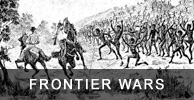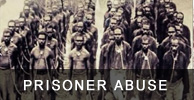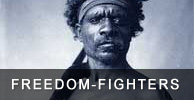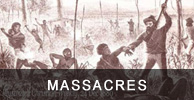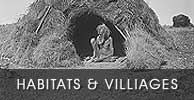Dundalli (1820–1855)
Understanding and Interpreting Dundalli Libby Connors pdf (62.77 KB)
Dundalli: A Turrwan an Aboriginal Leader 1842-1854 Dr Dale Kerwin pdf (3.66 MB)

Dundalli (c.1820-1855), Aboriginal leader, was born in the mountains (Blackall Range), north-west of Moreton Bay (Queensland). He probably came from the Dalambara clan of the Dalla language group. His name meant wonga pigeon. In August 1841 he was part of a delegation of Dalla who met German missionaries J. P. Niqué and A. T. W. Hartenstein on their journey north from Brisbane. From the mid-1840s he lived on Bribie Island, whose traditional owners, the Djindubari people, had adopted him.
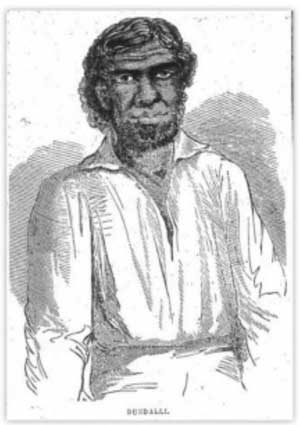
Enlarge
Dundalli (c.1820-1855)
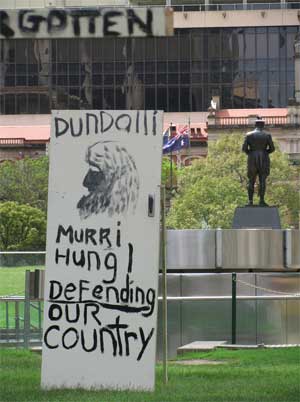
Accused of involvement in the spearing of a shepherd on the Archer brothers' Durundur station in 1843, Dundalli eluded capture. In 1845 a German missionary testified that he heard Dundalli issuing instructions to Aborigines engaged in robbing and then burning his hut. A mass attack on Andrew Gregor's station on the Pine River in October 1846, which resulted in the death of Gregor and his pregnant female servant, cemented Dundalli's growing reputation and triggered a series of reprisals and counter-reprisals. Evidence, often confused and based on rumour, allegedly linked Dundalli to the Gregor crime, an attack on three sawyers in September 1847 in which William Boller lost his life, the killing of a fisherman, Charles Gray, in 1849, the theft from the hut of a settler named Cash in 1852 and an attack on a shepherd named Halloran. Circumstantial evidence pointed to him, however, as an indigenous leader who was determined to repay violence with violence and to defend the honour and dignity of his people.
In a wave of frontier police actions, three of Dundalli's companions, including his brother Oumulli, were captured and killed, others were arrested or questioned and the death penalty was imposed and later remitted on another supporter Mickaloe. A legend grew up around Dundalli as he evaded capture over a fourteen-year period and the Whites sought to connect him with almost every act of violence committed on the northern side of the Brisbane River. The indigenous community was divided between those who supported and attempted to protect him and the traditional enemies of the Djindubari, who feared him and were prepared to inform the police of his whereabouts. One reason for his mystique was his size. His trial judge later wrote that Dundalli 'was the largest man I ever looked upon', well over six feet (183 cm) tall.
From May 1853 in Moreton Bay he worked for twelve months in the boat of William Wilson, a European and his name exchange 'brother'. Captured at Fortitude Valley in May next year, Dundalli was tried before (Sir) Roger Therry at the Brisbane Circuit Court in November. In his Reminiscences (London, 1863), Therry described how the prisoner brazenly attempted to bribe him, for sixpence, and on another occasion offered to row the judge to Sydney if he would release him. Dundalli was sentenced to death for the murders of Andrew Gregor and William Boller. The gallows were erected on the Queen Street footpath in front of Brisbane Gaol.
A crowd gathered to witness the execution on 5 January 1855 and the town constabulary and a detachment of native police surrounded the gallows to prevent any attempt at escape or rescue. As Dundalli mounted the scaffold he called out to a large number of indigenous people, who were gathered in the brushes that lined the Wickham Terrace hill, overlooking the scene, to avenge his death. They let out a loud cry when his body dropped. Alexander Green, the executioner sent from Sydney, bungled the hanging. Dundalli's feet fell upon his coffin, forcing Green to bend and drag on the hanged man's long legs until he died. This was the last official public execution in Queensland.
Dundalli was married, so it is likely that he had children. A sketch by Silvester Diggles, reproduced for the Illustrated Sydney News, shows Dundalli dressed in the open, smock shirt of a workingman of the 1850s, with wavy, black hair and neatly trimmed beard cut in the European style.
C. Campbell Petrie, Tom Petrie’s Reminiscences of Early Queensland (Brisb, 1904)
L. Connors, ‘The Theatre of Justice’, in R. Fisher (ed), Brisbane: The Aboriginal Presence 1824-1860 (Brisb, 1992)
Moreton Bay Courier, 27 May 1854, p 2, 25 Nov 1854, p 2, 6 Jan 1855, p 2, 13 Jan 1855, p 2
Illustrated Sydney News, 16 Dec 1854
Brisbane Courier, 18 Jan 1919
R v Dundalli, 9/6386 (State Records New South Wales).
Citation details
Libby Connors, 'Dundalli (1820–1855)', Australian Dictionary of Biography, National Centre of Biography, Australian National University, http://adb.anu.edu.au/biography/dundalli-12895/text23299, accessed 4 January 2013.
This article was first published in hardcopy in Australian Dictionary of Biography, Supplementary Volume, (MUP), 2005

